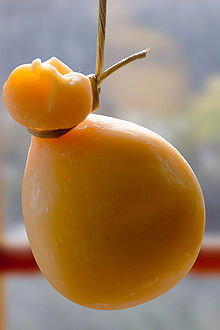Provolone

|
|
| origin | Italy ( Cremona , Piacenza , Brescia , Verona , Vicenza , Rovigo , Padua , Lodi , Bergamo , Mantua , Trento ) |
| milk | Cow / whole milk |
| treatment | Pasteurization |
| Cheese group | Sliced / hard cheese of the Filata type |
| Fat i. Tr. | 44% |
| Ripening time | 1–12 + months, depending on type |
| Manufacturer group | Consorzio Tutela Provolone |
| address | Piazza Marconi, 3 - 26100 Cremona , Italy |
Provolone or Provola is an Italian hard cheese / hard cheese of the Filata type with 44% fat i. Tr. The Provolone Valpadana DOP enjoys the status of a protected designation of origin .
history
The production area of the Provolone Valpadana today includes several northern Italian provinces. As a filata cheese, provolone originally belongs to the family of southern Italian cheeses. According to historical sources, it comes from Lucania and found its way to northern Italy during the Renaissance . After the unification of Italy in 1861, several southern Italian cheesemakers then moved to the fertile areas around the Po and began to produce their traditional cheeses there, albeit in larger quantities and in a larger variety of shapes. The name provolone, which is commonly used today, has only appeared since the end of the 19th century, and since then it has also been customary to produce it in larger loaves of up to a quintal. The cheese received the DOP designation on April 9, 1993, and has been protected throughout the EU since June 12, 1996 ( PDO / PDO ). The Consorzio Tutela Provolone Consortium, founded in 1975, today (as of 2002) comprises 30 producers who produce almost 100,000 tons of Provolone Valpadana annually and label their cheeses with the consortium mark in the form of a plaque or seal as a guarantee of quality.
variants
Provolone is commercially available in many different forms, each of which has its own name. There are cylindrical to sausage-shaped types called pancetta, pancettone or salamino, other forms are called gigante, gigantino or gigantone and look like constricted cones . A smaller variety is called Topolino ("little mouse"), the varieties Mandarino, Melon and Provole are spherical, and pear or bottle-shaped shapes are also common. Depending on your taste and artistic inclination, there are also cheesemakers who make provolones in animal form and other shapes. The size of the loaves varies between 0.5 kg and 100 kg. Ragusano DOP , similar to Provolone, is square and is considered a separate type of cheese. The most common form of provolone is round, oval or pear-shaped and is tied with a string and covered with a thin, smooth, yellow paraffin layer.
Provolone is made in two flavors. The Provolone dolce is with calf lab gekäst and matures four weeks to three months, the Tipo piccante Lab comes from sheep or goat , or a mixture of both used and maturity is at least three months, depending on size and up to one year. Some types of provolone are also offered smoked .
Properties and use
Provolone is a semi-hard cheese made from string dough, the dough is firm, slightly elastic, from white to light yellow in color and has few, irregular break holes and cracks. Its taste is mild and creamy in the dolce type , stronger to strong in the piccante type . As an exception, the food additive E 239 is permitted as a preservative for the production of Provolone (a decomposition product of this hexamethylenetetramine is formaldehyde).
Its good melting and thread-forming properties make the provolone ideal for seasoning starters and main dishes in warm dishes, it also goes well with vegetables, but it also tastes cold with bread. It is also part of the muffuletta from New Orleans and usually also the Philly cheesesteak . In Argentina and Uruguay , provolone from domestic production is grilled in slices 10 to 15 cm in diameter and 1 to 2 cm thick and is typically consumed as an appetizer with asado before the meat.
literature
- Gillian Riley: The Oxford Companion to Italian Food. Oxford University Press, 2007, p. 422.
- PF Fox: Cheese: Chemistry, Physics and Microbiology. Springer, 1999, pp. 234-237.
Web links
- Consorzio Tutela Provolone (Italian and English)
- Info page of ISMEA - Institute for Services for the Agricultural and Food Market ( Memento from February 1, 2014 in the Internet Archive )
